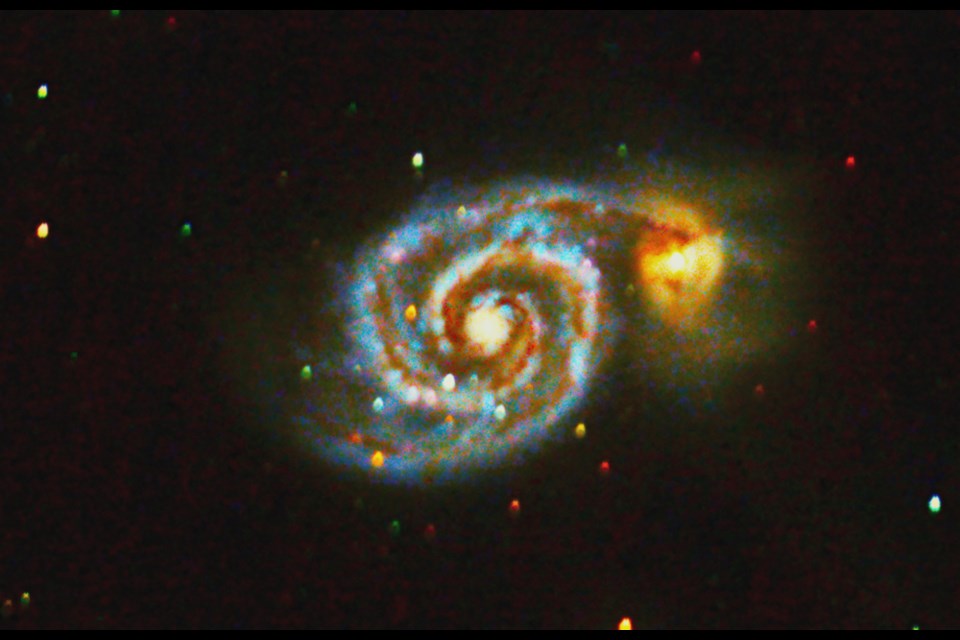Yuvnish Bhardwaj, who works in Squamish, spends many a cold night staring at the stars from the Tantalus Lookout.
Recently, he made the news in India for his shot of the Whirlpool Galaxy (Messier 51) that he captured in February.
He captured this image on April 4 with an Astro-modified Canon T2i and eight-inch Meade SC telescope with a focal length of 2,032 millimetres.
Bhardwaj said spots in Squamish are great places to shoot the stars because the area has relatively low light pollution.
"When it gets clear in Squamish, it gets really clear," he said. "There are no pollutants."
The Lookout is a popular spot for other amateur astronomers and photographers, he said.
About two or three days per month, the stars align, so to speak, and he sets up for the night to stargaze and take photos of what he sees.
His interest in the cosmos started as a boy in India.
He has lived in the Lower Mainland for about six years and started out going to the planetarium to see the stars and then sought out dark sky spots of his own.
Getting a good shot takes dedication and time, he noted. He spent several hours getting this Whirlpool shot and a few more doing the photo processing.
He is drawn to the idea that when you look at the Whirlpool Galaxy, you see into the past.
It is 30 million lightyears away.
The furthest object you can see with your naked eye is the andromeda galaxy, and that is two and a half million lightyears away," said Rachel Wang, HR MacMillan Space Centre astronomer.
She noted that the Whirlpool Galaxy is visible all year round but is best viewed from November to May.
"It is a particularly interesting galaxy because it was the first galaxy that was classified as a spiral galaxy," she said."It is also interesting because there is a galactic interaction component in addition to the structure. It is currently interacting with the smaller companion galaxy, which is M51B, and it looks really cool."
She said the larger galaxy seems to be devouring the smaller one.
"We call it galactic cannibalism. It is eventually going to merge into one big blob, but currently, it is interacting with it in that it is moving in and out of the disk," she said.
To see the Whirlpool Galaxy, find the Big Dipper, look at the last star on the handle and it is just below that.
Wang said that Bhardwaj's image is impressive for its detail.
Something to look skyward for next is the Lyrids, a medium strength shower that will peak April 21 to 22, she said.
"It is kind of the first meteor shower of the season, even though we have meteor showers all year round."
Tips for newbies
Suzanne Nagy is a 15-year member of the Royal Astronomical Society of Canada and is the current secretary of the board.
The Vancouver chapter of the group has about 300 members, while the larger organization has 30 centres across Canada with more than 5,000 national members.
For first-timers, she recommends using binoculars.
"It forces you to learn the night sky — where the constellations are," she said.
Nagy added there are a lot of things you can find looking up at night in a darker sky area like Squamish.
Next, if interested, move up to a telescope.
She said that telescopes' cost has come down significantly over the years, meaning it is accessible to more folks.
"You can buy a really good telescope for between $400 to $500 right now, which is relatively speaking not that expensive," she said.
Newbies to stargazing also need a star chart, Nagy said.
She recommends the book, NightWatch: A Practical Guide to Viewing the Universe, by Terence Dickinson.
It includes sky charts.
Nagy said she loves how stargazing puts things into perspective.
"If you put your mind to what is out there in the universe, it is astronomical, truly," she said.
"It fills you with a sense of wonder, but at the same time, it really makes you appreciate our own little ball of blue in this big, black universe that we exist in.... I really wish more world leaders and politicians would look through a telescope and their minds might expand further than just their own agendas."
She is most looking forward to Comet Swift–Tuttle in mid-August.
"It is the remnants of this comet that passed us by," she said. "When comets travel through the universe, they leave debris behind them. And so every year our planet Earth crosses the path of the debris left by Comet Swift–Tuttle."




